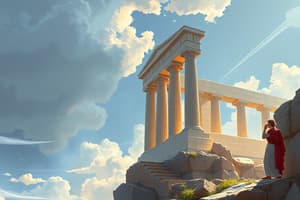Podcast
Questions and Answers
The Renaissance period revived classical Greek and Roman practices.
The Renaissance period revived classical Greek and Roman practices.
True (A)
The Middle Ages saw a decrease in Christian influence.
The Middle Ages saw a decrease in Christian influence.
False (B)
The Baroque and Neoclassical periods did not draw inspiration from classical antiquity.
The Baroque and Neoclassical periods did not draw inspiration from classical antiquity.
False (B)
The invention of photography did not impact the role of artists in the 19th century.
The invention of photography did not impact the role of artists in the 19th century.
La Edad Media es caracterizada por la influencia cristiana y la creación de obras como la Catedral de Notre Dame y las pinturas de Jesús y la Virgen María.
La Edad Media es caracterizada por la influencia cristiana y la creación de obras como la Catedral de Notre Dame y las pinturas de Jesús y la Virgen María.
El Neoclasicismo se extiende desde el 1400 hasta el 1800 y los artistas se inspiran en las épocas clásicas de Grecia y Roma.
El Neoclasicismo se extiende desde el 1400 hasta el 1800 y los artistas se inspiran en las épocas clásicas de Grecia y Roma.
El arte moderno del siglo XX incluye vanguardias como el expresionismo, cubismo y surrealismo, con obras como 'El grito' de Munch y el retrato cubista de Juan Gris.
El arte moderno del siglo XX incluye vanguardias como el expresionismo, cubismo y surrealismo, con obras como 'El grito' de Munch y el retrato cubista de Juan Gris.
El Renacimiento no tuvo ninguna influencia de las prácticas clásicas griegas y romanas.
El Renacimiento no tuvo ninguna influencia de las prácticas clásicas griegas y romanas.
La Edad Media se caracteriza por la influencia cristiana y la creación de obras como la Catedral de Notre Dame y las pinturas de Jesús y la Virgen María.
La Edad Media se caracteriza por la influencia cristiana y la creación de obras como la Catedral de Notre Dame y las pinturas de Jesús y la Virgen María.
El Neoclasicismo se extiende desde el 1400 hasta el 1800 y los artistas se inspiran en las épocas clásicas de Grecia y Roma.
El Neoclasicismo se extiende desde el 1400 hasta el 1800 y los artistas se inspiran en las épocas clásicas de Grecia y Roma.
El arte moderno del siglo XX incluye vanguardias como el expresionismo, cubismo y surrealismo, con obras como 'El grito' de Munch y el retrato cubista de Juan Gris.
El arte moderno del siglo XX incluye vanguardias como el expresionismo, cubismo y surrealismo, con obras como 'El grito' de Munch y el retrato cubista de Juan Gris.
El Renacimiento no tuvo ninguna influencia de las prácticas clásicas griegas y romanas.
El Renacimiento no tuvo ninguna influencia de las prácticas clásicas griegas y romanas.
Flashcards are hidden until you start studying
Study Notes
- The speaker is starting a video course on classical art history, assuming the viewer has no prior knowledge
- The course begins with ancient Greece and Rome, considered a classical period due to its influential impact on Western civilization
- The Roman and Greek cultures shared many similarities, including their use of Latin language and the Julian calendar
- Notable figures and works from the classical period include Plato, Aristotle, Euclid, Pitagoras, and myths like the Trojan War and the story of Hercules
- The Middle Ages (500-1400 AD) marked a significant increase in Christian influence and saw the development of the Romantic and Gothic styles
- The Renaissance (1400-1600 AD) revived classical Greek and Roman practices, producing famous works like Leonardo da Vinci's "Last Supper" and Michelangelo's "David"
- The Baroque and Neoclassical periods (1600-1800 AD) also drew inspiration from classical antiquity, leading to grandiose works like Bernini's "Ecstasy of St. Teresa" and Canova's "Venus Victrix"
- The Romantic, Realist, Impressionist movements of the 19th century saw artists express their personal perspectives, influenced by the political and industrial changes of the era
- The invention of photography in the 19th century changed the role of artists, leading to the emergence of modern art and movements like Expressionism, Cubism, and Surrealism.
Studying That Suits You
Use AI to generate personalized quizzes and flashcards to suit your learning preferences.




